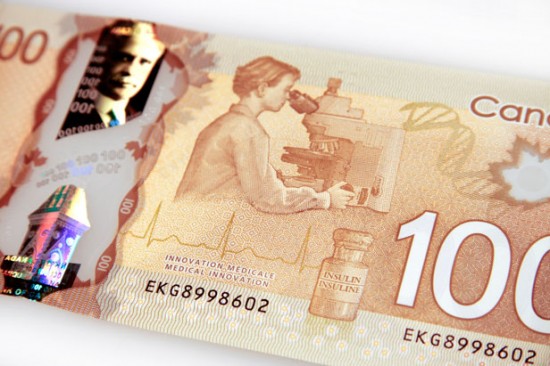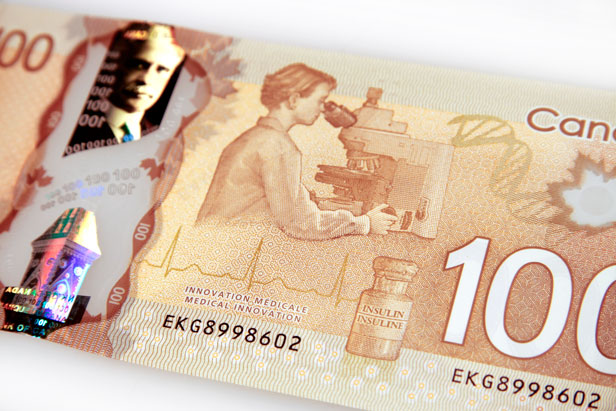Business Impact
Here Comes the Plastic Money
Polymer competes with paper as a basis for the world’s banknotes. Canada is the latest country to embrace plastic currency.



The Canadian dollar is worth as much as the U.S. greenback. But Canadians are abuzz about something else entirely: plastic money.
Last November, Canada introduced a plastic $100 bill, becoming one of about three dozen countries that have replaced at least some paper banknotes with bills printed on polymer. Beginning Monday, the Bank of Canada will begin circulating $50 bills made of the same material, and smaller denominations will follow next year.
The switch to polymer is the result of an effort to reduce one of the highest rates of counterfeiting among the world’s 20 largest economies. In 2004, Canada was finding 470 forged banknotes for every million in circulation. The Bank of Canada says the new notes are easy to verify and hard to counterfeit.
The new Canadian $100 bill feels slick, is hard to tear, and is stiffer than paper . But the most notable difference is that it features clear plastic windows, including one in the shape of a jagged-edged maple leaf with a smaller, frosted maple leaf within it. Looking through the leaf at a point light source reveals a hologram that displays “100.”
A second plastic window, running vertically on the right side of the bill, contains a metallic portrait of a building that changes color when the note is moved. “It makes it harder for professionals to counterfeit,” says David Menzies, strategic marketing manager at Securency International, the Australian company that produces the polymer substrate currently used in all polymer bills, including the Canadian ones. Australia was the first country to introduce plastic currency, with a commemorative $10 note in 1988. It began replacing its paper money in 1992.
The substrate consists of layers of biaxially oriented polypropylene—a plastic commonly used for packaging snacks or bagging lettuce. Securency can supply the plastic with a base of printed colors, as well as some security features. Rolls of the material are then shipped to individual countries, where printers can add additional features determined by the country’s central bank.
Menzies says both the intricacies of the see-through windows and other features make it hard for a person working with just a computer and a printer to replicate the polymer notes. That immediately undermines what he calls “casual counterfeiting,” in which a person in need of cash dummies up a quick and sloppy forgery on a laser printer. They could still be copied by more sophisticated forgers in organized crime or rogue governments (North Korea has produced nearly flawless copies of U.S. $100 notes), but the polymer’s features won’t make it easy.
Every country that has introduced polymer banknotes has seen a decrease in counterfeiting, says Stane Straus, a polymer-banknote collector in Kranj, Slovenia, who does consulting work for countries and companies working with the plastic money. “The challenge is to stay ahead of the counterfeiters in this game,” Straus says. “They will eventually catch up with everything you do, because everything can be counterfeited, but the polymer banknote offers more options for changes in the future.”
Some are skeptical about the advantages of plastic money, including Douglas Crane, vice president of Crane and Co., the Massachusetts family company that is the exclusive supplier of the paper that U.S. currency is printed on. Crane doesn’t think the polymer bills are so hard to fake, and he says that Mexico’s switch to 20- and 50-peso polymer notes hasn’t been very successful. “They have a very high counterfeiting problem on the 50-peso note,” he says.
Still, even countries that have stuck with paper bills are incorporating plastic into them. The next version of the U.S. $100 bill will contain a thin strip made of about 850,000 polymer microlenses. When the bill is tilted, the lenses will reveal one of two images printed beneath: the Liberty Bell or the number 100. The bill also features ink that changes color when viewed from different angles. The new $100 bill was due out in February, 2011, but production problems have delayed its release, according to the U.S. Federal Reserve.
Polymer notes cost about twice a much to produce as paper ones, but they could stay in circulation longer. A study requested by the Bank of Canada estimated that the new bills would last two and a half times as long as paper notes. Securency says they last four times as long.
All that could be bad news for banknote printers. “They will lose three-quarters of their business,” Straus says. Indeed, the currency printer BA International said it would shut down its banknote printing operation in Ottawa and lay off about 190 workers by the end of this year because of decreased demand for its services.
Don’t expect dollars or euros to go plastic anytime soon, however. Currencies tend to change slowly, because of both the lobbying power of banknote producers and the conservative nature of bankers. A spokesperson for the U.S. Bureau of Engraving and Printing says the government has investigated the use of plastic substrates but has no plans to introduce them. “The U.S. and the E.U. have to be very careful about new and untested technologies,” says Straus. “I think they will be one of the last to switch to polymer, because they want to be convinced beyond a doubt that there is no problem.”